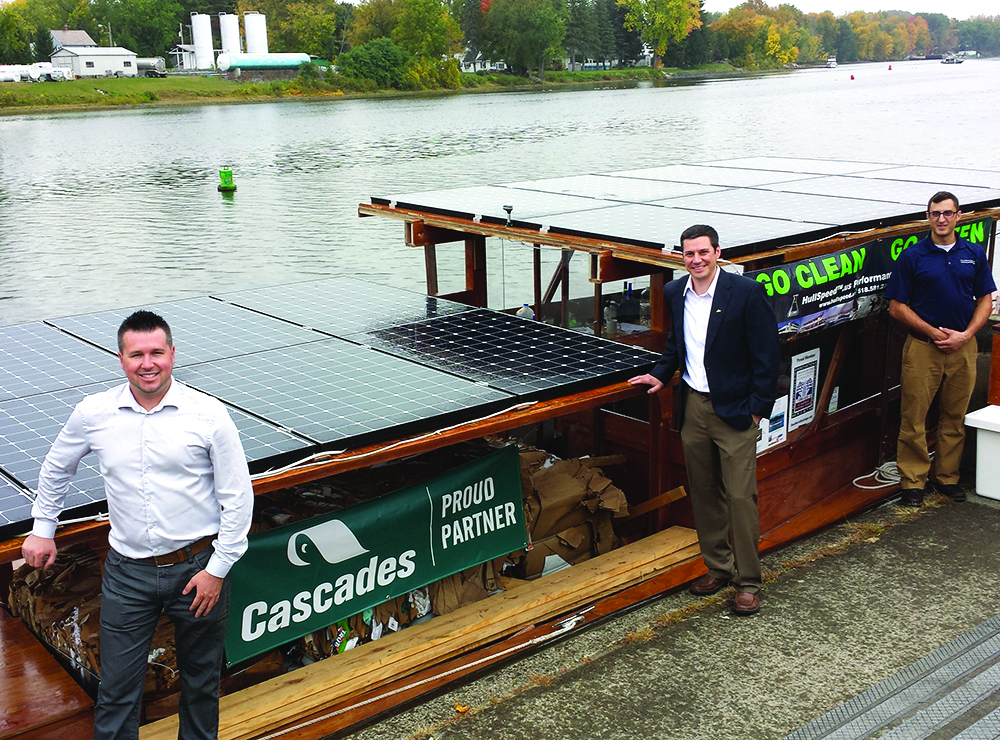
From left, Phillippe Bourassa and Andrew Sheridan of Cascades Tissue Group, and Ian Germain
of Greenfield Manufacturing/Hullspeed Performance Marine Coatings aboard Solar Sal.
On Oct. 13, Solar Sal, the award-winning
solar powered vessel honored as “best in show”
at the recent Waterford Tugboat Roundup,
became the first-ever boat to traverse the Erie
Canal and deliver a cargo without using a drop
of fossil fuels.
The Chamber of Southern Saratoga County
(CSSC) and several of its member manufacturing
companies were major supporters of the
trip. Quebec-based Cascades, Inc., which owns
tissue manufacturing plants in Mechanicville and Waterford, assisted in the operations, which involved loading six bales (8,000 pounds) of
recycled cardboard from Cascades Recovery’s
Depew, N.Y. facility aboard the boat in Lockport,
then traveling the roughly 320 miles to
Mechanicville for unloading near Cascades
Tissue Group’s local plant.
Hullspeed Coatings of Saratoga Springs,
which applied its signature product to the
vessel’s bottom before its spring launching, also assisted in the journey, with marketing
manager Ian Germain present for both loading
and unloading of the cargo.
Butler-Binley, of Bolton Landing, has a
20-plus year track record of building brands.
Professor David Borton departed Troy on
Sept. 19, cruising the entire length of the Erie
Canal from Waterford to the Niagara River,
returning to Lockport in time for the Sept. 29
loading, joined by CSSC President/CEO Pete
Bardunias and other volunteers.
Bardunias was enthusiastic about spending
six days aboard Solar Sal during its voyage.
“It’s not every day that one gets an opportunity
to make history, so I wanted to
be aboard,” he said. “With the Chamber of
Southern Saratoga County now so prominent
in the marine industry, it was important to be
there and share our story with the people we
encountered.”
He added, “Our goal is to manufacture these
vessels here in Saratoga County and have them
available to customers all over the state and
beyond.”
During Solar Sal’s journey, Borton showed
how the vessel could proceed solely on just
the incoming power from available sunlight.
Its solar arrays can gain energy from minimal
daylight, and Solar Sal’s battery reserve allows
for some running even at night (maximum
range on a full charge is 50 miles).
Solar Sal performed well, despite significant
overcast and rain for several days. She easily
reached her top speed of 7 knots when called
for, and in direct sunlight could sustain a 5
knot cruising speed (same as commercial tugs
travel in the canals) using only four kilowatts
of power. Since the solar arrays can deliver five
kilowatts on a nice day, a reasonable speed can
be achieved while more energy flows into the
boat’s batteries than it is using, in essence the
boat is refueling while underway, according to
Borton. Given the nature of their endurance
run, the inclement weather required slower
speeds to achieve the same effect, but crossing
Oneida Lake’s 20-mile length, Solar Sal’s gauges
indicated that they were indeed taking on more
“fuel” than being consumed to do the crossing.
The voyage passed 320 miles of towns,
bed and breakfasts, hotels, waterfront parks,
marinas, restaurants and other attractions.
Residents of the canal-side communities expressed
hope for new industries to revitalize
some of these towns and help build the upstate
economy, Bardunias said. Many of these towns
have waterfront commercial facilities which are
falling into disrepair or have been dormant for
many years.
The voyage of Solar Sal coincided with some
work done by a fellow CSSC member, the state
Marine Highway tug Margot, which carried
stone on the Champlain Canal and later moved
heavy equipment into western New York via the
Erie. While tugs are seen fairly often between
Waterford and Oswego, it is unusual that they
are used in some of the other stretches. Solar
Sal and Margot are at opposite ends of the
spectrum, but they both traveled on rarely-used
canal stretches this October.
“The canals are still available as a vastly
underutilized resource for both the environmentally-
sustainable delivery of cargo and the
carrying of people, whether as a tour boat for
hire or a customized, private yacht. That is what
we’ve envisioned for Solar Sal,” said Borton.
Because Solar Sal’s design can accommodate
a 12-ton payload it is very versatile, with multiple
possible uses. For example, if finished as
a private trawler-style yacht, there’s room for
a cozy cabin for cruising boaters. Substitute a
module with open seating and it could be an
equally effective tour boat (the weight of 40
passengers was carried on the delivery voyage).
Other possibilities include short haul cargoes
of heavy goods, recyclables, trash, or even fuel
oil (why use fuel to move fuel?). Bardunias
said Solar Sal could be a useful platform to
create floating farmers markets or small-scale
transportation of food to downstate New York
residents.
For more information on marine cargo
transportation, contact the Chamber of Southern
Saratoga County at 371-7748 or email
pete@southernsaratoga.org .
